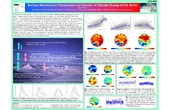Surface Atmospheric Temperature as Indicator of Climate Change in the Arctic
Conference poster
Permanent lenke
https://hdl.handle.net/1956/1810Utgivelsesdato
2005-12Metadata
Vis full innførselSamlinger
Sammendrag
Surface atmospheric temperature (SAT) is one of the most reliable atmospheric characteristics used to quantify climate change. Contrary to what has been always implicitly assumed, changes in the SAT have loose relations with changes in trends in the tropospheric and its heat content (Scheme 1, [1]). Physical reasoning suggests that the thin Arctic planetary boundary layer (PBL) would quickly equilibrate its temperature with the surface (usually low) temperature. A thicker, storm-mixed PBL conveys the turbulent mixing deeper into the inverselystratified troposphere and hence maintains warmer SAT (Fig. 1). Observations revealed that these two mixing regimes produce a bi-modal distribution in the SAT (Fig. 2) corresponding to “coreless winters”[2]. The bi-modality may have profound impact on the perception of the Arctic climate given that the SAT is warmer and less variable in deep PBLs (Fig. 3). The trends should be a combination of trends (Fig. 4) due to changes in the heat content and due to changes in the occurrence of the deep mixing. The latter reflects rather changes in storm activity (wind speed trend, Fig. 5) than changes in a local heat budget. The warming tropospheric trends expected from the radiation greenhouse and polar amplification [3] should result in thinning not thickening of the PBL (Fig. 1), thus, leading to a weaker warming or even cooling traced in the heat content or even SAT (Fig. 4).
Beskrivelse
Poster presented at the American Geophysical Union (AGU) Fall Meeting, 5-9 December, San-Francisco, USA. Session A33D-0935
